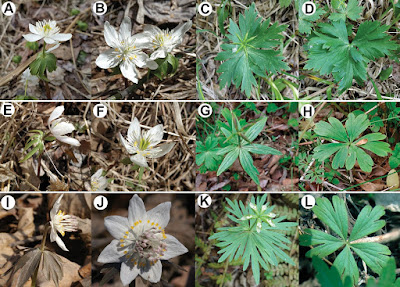 |
| Eranthis tanhoensis Erst
in Erst, Sukhorukov, Mitrenina, et al., 2020.
|
Abstract
A new endemic species, Eranthis tanhoensis sp. nov., is described from the Republic of Buryatia and Irkutsk Province, Russia. It belongs to Eranthis section Shibateranthis and is morphologically similar to E. sibirica and E. stellata. An integrative taxonomic approach, based on cytogenetical, molecular and biochemical analyses, along with morphological data, was used to delimit this new species.
Keywords: Biochemistry, cytology, integrative taxonomic approach, morphology, phylogeny, Ranunculales, Russia
 |
| Figure 5. General habit of Eranthis tanhoensis. Scale bar: 1 cm. |
Eranthis tanhoensis Erst, sp. nov.
Notes: Turczaninow (1842) described the species E. uncinata Turcz., growing at higher altitudes and distinguished from E. sibirica by the number of petals (5–6, not strictly 5), by the shape of the stylodium (recurved rather than straight), smaller flowers and more dissected leaf blades. However, our studies have shown that these morphological characters are variable and all variations can be found both in the foothill and alpine plants. Shipchinskiy (1937) merged E. uncinata with E. sibirica. However, he described two varieties: E. sibirica DC. var. nuda Schipcz. with glabrous pedicels (= E. sibirica var. sibirica) and E. sibirica DC. var. glandulosa Schipcz. with glandular-pubescent pedicels. These varieties were not validly published under ICN Article 39.1 (Turland et al 2018). Nakai (1937) attributed E. sibirica and E. uncinata to the genus Schibateranthis Nakai (≡ Eranthis sect. Schibateranthis (Nakai) Tamura).
Affinity: The new species belongs to E. sect. Shibateranthis (Nakai) Tamura and it is sister to E. sibirica, according to the results of molecular phylogenetic analysis (Fig. 1). E. tanhoensis is morphologically similar to E. sibirica and E. stellata (Figs 5–9) in having white sepals, tubular two-lipped petals with bilobate or forked lips, apically acute lobes with abaxial lip and globular yellow swellings (nectaries) at the top or in the central part. The differences amongst the three species are presented in Table 2.
Distribution: (Fig. 10): Eranthis tanhoensis is endemic to southern Baikal (Khamar-Daban range of the Republic of Buryatia and Irkutsk Province).
Habitat and ecology: Eranthis tanhoensis can be found at 350–2400 m a.s.l., where it grows in fir, Siberian pine, spruce and birch forests, on riverbanks, beside streams (up to 1500 m a.s.l.) and in subalpine meadows (at higher altitudes).
Etymology: The specific epithet of the new species is derived from the type locality, Tanhoi village, Republic of Buryatia, Russia.
Andrey S. Erst, Alexander P. Sukhorukov, Elizaveta Yu. Mitrenina, Mikhail V. Skaptsov, Vera A. Kostikova, Olga A. Chernisheva, Victoria Troshkina, Maria Kushunina, Denis A. Krivenko, Hiroshi Ikeda, Kunli Xiang and Wei Wang. 2020. An Integrative Taxonomic Approach reveals A New Species of Eranthis (Ranunculaceae) in North Asia. PhytoKeys. 140: 75-100. DOI: 10.3897/phytokeys.140.49048

